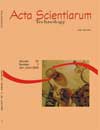Preliminary studies on mud stabilization / solidification, from textile laundry treatments, for re-utilization as building mortar
DOI:
https://doi.org/10.4025/actascitechnol.v24i0.2494Keywords:
efluentes líquidos, lodo têxtil, E/S, reutilização, argamassas de construçãoAbstract
The laundries and industrial dry cleaner's generate liquid effluents that, after treatment for matter in suspension floculation, produce sludge. This residue has varied chemical composition, due to the products used in the process. Such residue is considered inadequate for in natura disposition in the environment, and it should have, as final destination, an industrial landfill. In the studied case, such industrial landfill is not available and the residues are truck-driven for about 400 Km, causing a strong financial impact over the production of an emergent local textile industry market. This work presents the physical-chemical characterization of the sludge produced by an industrial laundry, studying its final disposition in the process of E/S addition in Portland cement, seeking its re-utilization in civil construction materials, to minimize this residue's final disposition costs. The analysis contemplated: COD total, fixed and volatile solids in the sludge, sludge density, pH and metals presence. The presence of the metals: Fe, Mg, Al, Sn, Ca, Cr, Co, Cu, Mn and Zn was detected in the sludge. The incorporation of this sludge in mortar was studied as residue final destination. Samples of this mortar were submitted to compression resistance analysis. Results demonstrate that the mortar with sludge contents lower than 25% in relation to the cement mass, after 28 days, shows mechanical resistance values larger than 10 Mpa, being fit to be used as civil construction secondary material, without structural function. Posterior studies will be necessary to evaluate the organic matter influence in the composite's durability.Downloads
Download data is not yet available.
Downloads
Published
2008-04-22
How to Cite
Pietrobon, C. L. da R., Bitencourt, M. P. de, Gimenes, M. L., Bergamasco, R., Colanzi, J., & Pietrobom, C. E. (2008). Preliminary studies on mud stabilization / solidification, from textile laundry treatments, for re-utilization as building mortar. Acta Scientiarum. Technology, 24, 1659–1664. https://doi.org/10.4025/actascitechnol.v24i0.2494
Issue
Section
Chemical Engineering
License
DECLARATION OF ORIGINALITY AND COPYRIGHTS
I Declare that current article is original and has not been submitted for publication, in part or in whole, to any other national or international journal.
The copyrights belong exclusively to the authors. Published content is licensed under Creative Commons Attribution 4.0 (CC BY 4.0) guidelines, which allows sharing (copy and distribution of the material in any medium or format) and adaptation (remix, transform, and build upon the material) for any purpose, even commercially, under the terms of attribution.
Read this link for further information on how to use CC BY 4.0 properly.
0.8
2019CiteScore
36th percentile
Powered by 



0.8
2019CiteScore
36th percentile
Powered by 

















8.png)




